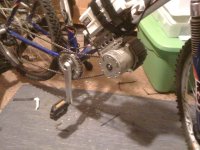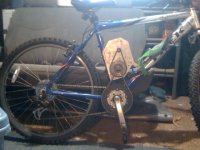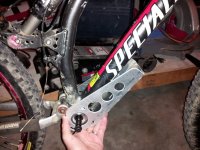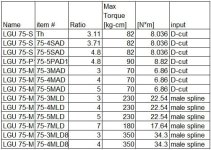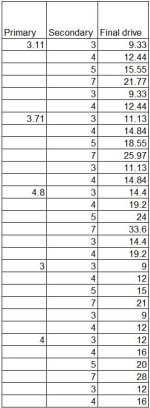I have a bike that's close to this design. I've been thinking about doing a Kickstarter project to see if there was interest in the mid-drive approach.
I have a freewheel on the bottom bracket and a MAC like motor with a planetary reduction.
Here are some rough specs:
300 W
24 V, 12 Ah battery
Geared low for hill climbing so top speed is ~18 mph. Low gear top speed is ~5 mph. Personally I prefer the mountain gearing but if flats and speed were preferred I could adjust accordingly, however, I would hit a motor power limit fairly quickly which would require some beefier gears (to hit speeds in the 30 mph range).
~20 mile range
On trek 4200 weight is 42 lbs with battery
The gears are tuned to pedal cadence.
I've made a few revisions of this basic setup. The latest adapts to the bottom bracket and I'm in the process of assembling this version. The version I currently ride required me to weld some tabs to the down tube. I've put lots of miles on this version.
It's a tough setup. I take it on trails and bash it hard. I love it, though it's not without shortcomings.
I would like to switch to an IGH hub, and I have had some cassettes lose teeth due to late shifts while under full power.
Also pictured are my very original version with a chain drive. It was loud but still surprisingly reliable. I put ~4000 miles on that setup. The CAD is for the current build I'm working on.
I have a freewheel on the bottom bracket and a MAC like motor with a planetary reduction.
Here are some rough specs:
300 W
24 V, 12 Ah battery
Geared low for hill climbing so top speed is ~18 mph. Low gear top speed is ~5 mph. Personally I prefer the mountain gearing but if flats and speed were preferred I could adjust accordingly, however, I would hit a motor power limit fairly quickly which would require some beefier gears (to hit speeds in the 30 mph range).
~20 mile range
On trek 4200 weight is 42 lbs with battery
The gears are tuned to pedal cadence.
I've made a few revisions of this basic setup. The latest adapts to the bottom bracket and I'm in the process of assembling this version. The version I currently ride required me to weld some tabs to the down tube. I've put lots of miles on this version.
It's a tough setup. I take it on trails and bash it hard. I love it, though it's not without shortcomings.
I would like to switch to an IGH hub, and I have had some cassettes lose teeth due to late shifts while under full power.
Also pictured are my very original version with a chain drive. It was loud but still surprisingly reliable. I put ~4000 miles on that setup. The CAD is for the current build I'm working on.



